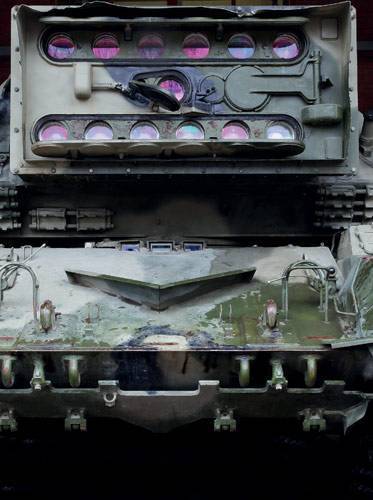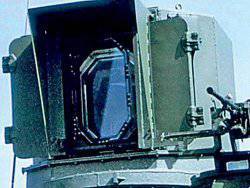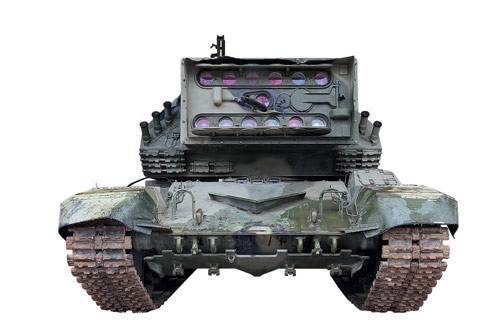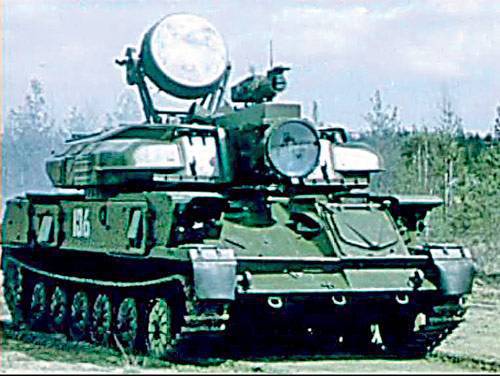Self-propelled laser complexes
 “But we cannot tell you about the second car that you indicated in your fax. The secrecy bar has not been removed from it yet, ”- the person at the end of the line was not at ease even to pronounce the name of the self-propelled laser complex 1K17“ Compression ”
“But we cannot tell you about the second car that you indicated in your fax. The secrecy bar has not been removed from it yet, ”- the person at the end of the line was not at ease even to pronounce the name of the self-propelled laser complex 1K17“ Compression ”FSUE NPO Astrofizika, within which this impressive facility was developed, refused to give any comments on its design, principle of operation, tactical objectives and technical characteristics.
Meanwhile, our interest was not at all caused by contempt for state secrets. We saw and freely photographed the SLC “Compression” in the Military-Technical Museum, recently opened in the village of Ivanovo, Moscow Region. There is a rare exhibit also exhibited without annotations. They say that the copied copy, in a very depressing state, was transferred to the museum by a certain military unit near Kolomna. The local warriors did not tell about the appointment of the apparatus: not because it was secret, but because they themselves somehow did not think about it. Otherwise would not have given.
We tried to figure out why the “laser tank"Sixteen" eyes "and how secret is that which is put on public display under the heading of secrecy.
Stiletto: Dead Souls
The second half of the 20th century can rightfully be called the epoch of laser euphoria. Theoretical advantages of laser weapons, with the speed of light striking a target in direct fire, regardless of wind and ballistics, were obvious not only to science fiction. The first working laser sample was created in 1960, and already in 1963, a group of specialists from the Vympel design bureau began the development of an experimental laser locator LE-1. It was then that the main body of scientists of the future NGO Astrophysics was formed. At the beginning of the 1970-s specialized laser design bureau finally took shape as a separate enterprise, received its own production facilities and bench testing base. An interdepartmental research center of the OKB “Raduga” was established, hiding from prying eyes in the numbering city of Vladimir-30.
 The SLT 1K11 “Stilet” turret housed a combat laser targeting system based on large mirrors.
The SLT 1K11 “Stilet” turret housed a combat laser targeting system based on large mirrors.In 1978, the NGO Astrophysics was formed, in which Nikolai Dmitrievich Ustinov, the son of USSR Defense Minister Dmitry Ustinov, took the post of general designer. It is difficult to say whether this has affected the already successful development of NGOs in the field of military lasers. Anyway, already in 1982, the first self-propelled laser complex 1K11 Stilet was commissioned by the Soviet army.
Stilet was intended to disable the optical-electronic guidance systems of the enemy’s weapons. Its potential targets are tanks, self-propelled artillery installations and even low-flying helicopters. Having found the target by means of radiolocation, Stilet made its laser sounding, trying to detect optical equipment using glare lenses. Having precisely localized the “electronic eye”, the device hit it with a powerful laser pulse, blinding or burning out a sensitive element (photocell, photosensitive matrix, or even the retina of the aiming fighter's eyes).
The horizontal guidance of a combat laser was carried out by turning the turret, vertically - using a system of precisely positioned large-size mirrors. The accuracy of aiming "Stiletto" no doubt. To get an idea of it, it is enough to recall that the LE-1 laser locator, from which Astrophysics began, was able to send 196 laser beams into the target space, a ballistic missile flying at a speed of 4 – 5 km / s, in a fraction of a second.
The 1K11 laser system was mounted on the GMZ chassis (tracked mine layer) of the Sverdlovsk plant Uraltransmash. Only two machines, differing from each other, were manufactured: in the course of testing, the laser part of the complex was modified and changed.
Formally, the SLK "Stilet" to this day is in service with the Russian army and, as the saying goes historical The brochure of NPO Astrophysics meets the modern requirements of conducting military-tactical operations. But sources at Uraltransmash claim that 1K11, except for two experienced ones, was not collected at the plant. A couple of decades later, both machines were discovered in a disassembled form, with the laser part removed. One was disposed of in the sump of the 61st BTRZ near St. Petersburg, and the other was disposed of at a tank repair plant in Kharkov.
"Sanguin": at the zenith
The development of laser weapons at NPO Astrofizika was at the Stakhanov pace, and already in 1983, the Sangwin SLC was commissioned. Its main difference from the Stiletto was that the combat laser was aimed at the target without using large mirrors. The simplification of the optical scheme had a positive effect on the damaging ability of the weapon. But the most important improvement was the increased mobility of the laser in the vertical plane. "Sanguin" was intended to destroy optical-electronic systems of air targets.
The shot resolution system specially designed for the complex allowed him to successfully shoot at moving targets. On tests, SLCV demonstrated the ability to stably determine and hit the helicopter optical systems at ranges over 10 km. At close distances (up to 8 km), the device completely disabled the sights of the enemy, and at the extreme ranges blinded them for tens of minutes.
The Sangvina laser complex was mounted on the Shilka self-propelled anti-aircraft chassis. In addition to the battle laser, a low-power probe laser and a guidance system receiving device were mounted on the tower, recording the reflections of the probe beam from the glare object.
Three years after the “Sanguine”, the arsenal of the Soviet army was supplemented with the Aquilon shipborne laser complex with a principle of operation similar to that of the ground-based SLK. Marine-based has an important advantage over land: the power system of a warship can provide significantly more electricity for pumping a laser. So, you can increase the power and rate of guns. The complex "Aquilon" was intended to destroy the optical-electronic systems of the coast guard of the enemy.

Optics vs. Optics
The upper and lower rows of lenses of the SLC “Compression” are emitters of a multichannel combat laser with an individual guidance system. In the middle row are the lenses of guidance systems.
"Compression": laser rainbow
SLK 1K17 “Compression” was put into service in 1992 year and was much better than “Stiletto”. The first difference that catches the eye is the use of a multichannel laser. Each of the 12 optical channels (upper and lower row of lenses) had an individual guidance system. The multichannel circuit made it possible to make the laser setup multi-band. As a countermeasure to such systems, the enemy could protect his optics with light filters that block the radiation of a certain frequency. But against simultaneous damage by rays of a different wavelength, the light filter is powerless.
Lenses in the middle row are related to aiming systems. The small and large lenses on the right are the probe laser and the receiving channel of the automatic guidance system. The same pair of lenses on the left is optical sights: small day and large night. The night sight was equipped with two laser illuminators, range finders. In the traveling position and optics guidance systems, and emitters were closed armored plates.
In SLC “Compression” a solid-state laser with fluorescent pump lamps was used. Such lasers are compact enough and reliable for use in self-propelled installations. This is evidenced by foreign experience: in the American system ZEUS, installed on the Humvee all-terrain vehicle and designed to “set fire” enemy mines at a distance, a laser with a solid working fluid was mainly used.
In amateur circles goes bike about 30-kilogram of ruby crystal, grown specifically for the "Compression". In fact, ruby lasers are outdated almost immediately after their birth. Nowadays, they are used except to create holograms and tattoos. The working body in 1K17 could well be an aluminum yttrium garnet with neodymium additives. The so-called YAG lasers in a pulsed mode are capable of developing impressive power.
Generation in YAG occurs with a wavelength of 1064 nm. This is infrared radiation, which in the weather is subject to scattering to a lesser extent than visible light. Due to the high power of a YAG laser on a nonlinear crystal, harmonics can be obtained — pulses with a wavelength twice, three times, four times shorter than the original. In this way multiband radiation is generated.
The main problem of any laser is extremely low efficiency. Even in the most modern and complex gas lasers, the ratio of the radiation energy to the pump energy does not exceed 20%. Pumping lamps require a lot of electricity. Powerful generators and an auxiliary power unit took up most of the increased cutting of the self-propelled 2C19 “Msta-S” self-propelled artillery system (already large), on the basis of which the SLC Compression was built. Generators charge a capacitor battery, which, in turn, gives a powerful pulse discharge to the lamps. It takes time to “fill up” capacitors. The rate of fire of the SLC “Compression” is, perhaps, one of its most mysterious parameters and, perhaps, one of the main tactical shortcomings.

SLC "Sanguin" is actually a laser anti-aircraft installation and serves to destroy optical-electronic devices for airborne targets.
In secret around the world
The most important advantage of laser weapons is direct fire. Independence from the vagaries of the wind and the elementary aiming scheme without ballistic corrections means firing accuracy not available to conventional artillery. If you believe the official brochure of the NGO Astrophysics, which claims that the Sanguin could hit targets at a distance over 10 km, the range of the Compression is at least twice the firing range of, say, a modern tank. So, if a hypothetical tank approaches an 1K17 in an open area, it will be disabled before it opens fire. It sounds tempting.
However, direct aiming is both the main advantage and the main drawback of laser weapons. For his work requires direct visibility. Even if you fight in the desert, the 10-kilometer mark will disappear over the horizon. To meet guests with blinding light, a self-propelled laser must be put on the mountain for all to see. In real terms, this tactic is contraindicated. In addition, the vast majority of theaters of war have at least some relief.
And when the same hypothetical tanks are at a distance of a shot from the SLC, they immediately receive advantages in the form of a rate of fire. "Compression" can neutralize one tank, but while the capacitors are charged again, the second will be able to avenge the blind comrade. In addition, there are weapons far more long-range than artillery. For example, a Maverick rocket with a radar (non-dazzling) guidance system is launched from a distance of 25 km, and overlooking the vicinity of the SLC on the mountain is an excellent target for it.
Do not forget that dust, fog, precipitation, smoke screens, if they do not negate the effect of an infrared laser, then at least significantly reduce the range of its action. So the self-propelled laser complex has, to put it mildly, a very narrow area of tactical use.
Why were SLC “Compression” and its predecessors born? On this subject, there are many opinions. Perhaps, these devices were considered as test benches for testing future military and military space technologies. Perhaps the military leadership of the country was ready to invest in technologies, the effectiveness of which at that time seemed dubious, hoping to find out the empowerment of the future by experience. Or maybe three mysterious machines with the letter “C” were born because Ustinov was the general designer. More precisely, the son of Ustinov.
There is a version that SLK “Compression” is a weapon of psychological action. Only the likelihood of the presence of such a machine on the battlefield makes gunners, observers, snipers wary of optics under the fear of losing sight. Contrary to popular belief, “Compression” is not subject to the UN Protocol prohibiting the use of blinding weapons, as it is intended to destroy optical-electronic systems, and not personnel. The use of weapons for which blinding people is a possible side effect is not prohibited.
This version partly explains the fact that news on the creation in the USSR of the strictest secret weapons, including the Stiletto and Squeeze, quickly appeared in the free American press, in particular in the Aviation Week & Space Technology magazine.
- Sergey Apresov, Alexey Khlopotov
- http://www.popmech.ru"rel =" nofollow ">http://www.popmech.ru
Information